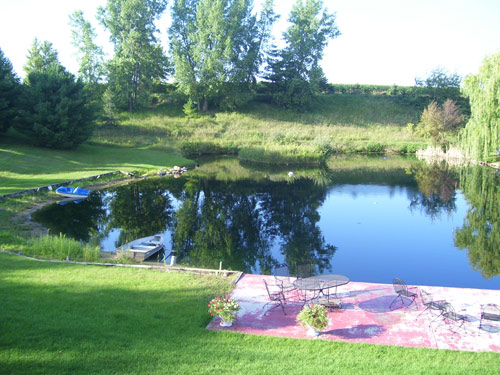We all know that a pond is indeed a very nice addition to any property as it adds a natural element to your backyard, enticing wildlife to stay in and around it. It is indeed a valuable aesthetic component of your property so you have to make sure that it is always looking its best and does not become an eyesore due to improper care. All of this is possible by making the right choices ahead of time pertaining to fish, plants and design. Although many people cringe at the sight of algae, it is quite necessary to have at least ‘some’ algae present to help stabilize the ecosystem. Pond algae are often misunderstood pond element. Most pond owners usually see pond algae as a nuisance or as a bad thing to see in a pond. On the contrary, algae help balance the level of oxygen in the pond water. It provides more oxygen in the water. However, pond algae need to be controlled so that the balance you are looking for can be achieved.
On way to control pond algae is through the application of dyes or colorants along with chemical or biological treatments as combined, these substances help get rid of excess algae formation and other nuisance aquatic plants. It is a fact that algaecides and herbicides are available in the market for any pond owner to get rid of their pond algae problem with the main chemical compounds in these products being Floridone, Endothall, Diquat, and Copper Sulfate. There are irrigation restrictions, species limitation, and residues that pond owners tend to be very apprehensive about that is why they already think twice about using them. Plus, they only target the symptoms instead of dealing with the main problem. That is why pond dyes and colorants are now being used as organic solutions to the pond algae issue.
Ready-made algaecides and herbicides tend to be expensive especially when used in large amounts. Pond dyes and colorants are inexpensive. They are also all natural solutions to eliminating pond algae and submerged aquatic plants. Algae and aquatic plants need sunlight combined with the nutrients in the water. These organisms proliferate when there is enough light in a specific area of the water called the “photic zone”. To control the amount of water plants and pond algae, you have to limit the amount of light that enters the pond. You can do this without hurting your natural pond environment by introducing pond dyes and colorants. The colorants block the sunlight and prevent it from penetrating the lower part of the pond. As a result, the algae and the plants cannot grow anymore. This limited growth also reduces the biomass present in your pond. Don’t worry about your floating plants or cattails. The dyes do not harm them or inhibit their growth at all.
Pond dyes and colorants are only effective depending on the dosage rates, maintenance schedule, watershed conditions, and the season you apply them in your pond. It is ideal to apply the pond colorants and dyes in the early days of spring so that you could immediately prevent the germination and growth or the nuisance water plants and algae. To get the right color in your pond, you have to balance your water volume with your dye dosages. For every acre of pond or 5 acre feet with a depth of about r5 feet, you should use a gallon of pond colorants or dyes. You have to maintain the color of your pond all throughout the season. If you see the color fading, simply add more dye.
You can easily use pond dyes and colorants. Just pour them along the edges of your pond…It will naturally disperse throughout the entire pond through the natural movements of the water. In just a day, you will have a fully colored pond. Don’t worry about becoming blue when you immerse yourself into the water. The dye or colorant will not stain your skin anymore when it is completely dispersed. Resorting to natural pond dyes and colorants is an environment friendly, affordable, and easy way to prevent or control pond algae in your pond.
